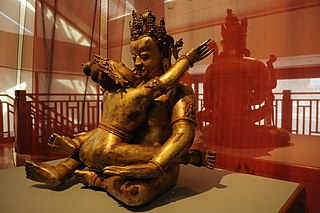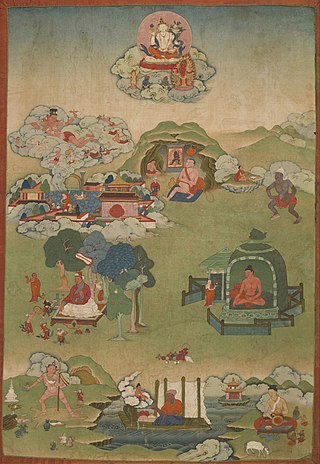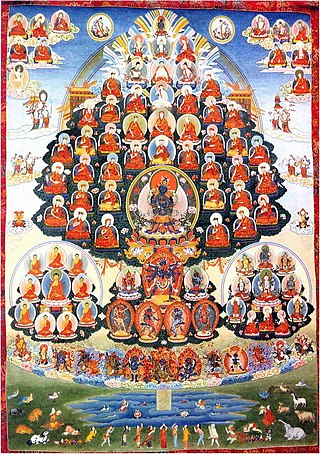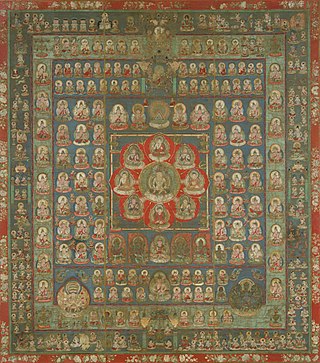Tantric may refer to:
Tantric may refer to:

Chakras are various focal points used in a variety of ancient meditation practices, collectively denominated as Tantra, or the esoteric or inner traditions of Hinduism and Buddhism.

Tibetan Buddhism is a form of Buddhism practiced in Tibet, Bhutan and Mongolia. It also has a sizable number of adherents in the areas surrounding the Himalayas, including the Indian regions of Ladakh, Sikkim, and Arunachal Pradesh, as well as in Nepal. Smaller groups of practitioners can be found in Central Asia, Xinjiang, Inner Mongolia, and some regions of Russia, such as Tuva, Buryatia, and Kalmykia.

Tantra is an esoteric yogic tradition that developed on the Indian subcontinent from the middle of the 1st millennium CE onwards in both Hinduism and Buddhism.

Vajrayāna, also known as Mantrayāna, Mantranāya, Guhyamantrayāna, Tantrayāna, Tantric Buddhism, and Esoteric Buddhism, is a Buddhist tradition of tantric practice that developed in Medieval India and spread to Tibet, Nepal, other Himalayan states, East Asia, and Mongolia.

Mahāmudrā literally means "great seal" or "great imprint" and refers to the fact that "all phenomena inevitably are stamped by the fact of wisdom and emptiness inseparable". Mahāmudrā is a multivalent term of great importance in later Indian Buddhism and Tibetan Buddhism which "also occurs occasionally in Hindu and East Asian Buddhist esotericism."

Tantric sex or sexual yoga refers to a range of practices in Hindu and Buddhist tantra that utilize sexuality in a ritual or yogic context. Tantric sex is associated with antinomian elements such as the consumption of alcohol, and the offerings of substances like meat to deities. Moreover, sexual fluids may be viewed as power substances and used for ritual purposes, either externally or internally.

A ḍākinī is a type of female spirit, goddess, or demon in Hinduism and Buddhism.

A ganacakra is also known as tsok, ganapuja, cakrapuja or ganacakrapuja. It is a generic term for various tantric assemblies or feasts, in which practitioners meet to chant mantra, enact mudra, make votive offerings and practice various tantric rituals as part of a sādhanā, or spiritual practice. The ganachakra often comprises a sacramental meal and festivities such as dancing, spirit possession, and trance; the feast generally consisting of materials that were considered forbidden or taboo in medieval India like meat, fish, and wine. As a tantric practice, forms of gaṇacakra are practiced today in Hinduism, Bön and Vajrayāna Buddhism.
Phowa is a tantric practice found in both Hinduism and Buddhism. It may be described as "transference of consciousness at the time of death", "mindstream transference", "the practice of conscious dying", or "enlightenment without meditation". In Tibetan Buddhism phowa is one of the Six yogas of Naropa and also appears in many other lineages and systems of teaching.
Neotantra, navatantra, or tantric sexuality is a Western new religious movement influenced by the Eastern esoteric spiritual traditions of Tantra. Rooted in elements of Hindu and Buddhist tantras, neotantra blends New Age interpretations with modern Western perspectives, often emphasizing the sexual aspects of these ancient traditions. While some proponents reference traditional texts and principles, many utilize tantra as a broader term encompassing sacred sexuality, occasionally incorporating unconventional practices. However, neotantra does not always adhere to the complete range of Indian tantric practices, particularly the reliance on a guru.

Buddhist tantric literature refers to the vast and varied literature of the Vajrayāna Buddhist traditions. The earliest of these works are a genre of Indian Buddhist tantric scriptures, variously named Tantras, Sūtras and Kalpas, which were composed from the 7th century CE onwards. They are followed by later tantric commentaries, original compositions by Vajrayana authors, sādhanas, ritual manuals, collections of tantric songs (dohās) odes (stotra), or hymns, and other related works. Tantric Buddhist literature survives in various languages, including Sanskrit, Tibetan, and Chinese. Most Indian sources were composed in Sanskrit, but numerous tantric works were also composed in other languages like Tibetan and Chinese.

Vajrasattva is a bodhisattva in the Mahayana and Mantrayana/Vajrayana Buddhist traditions. In Chinese Buddhism and the Japanese Shingon tradition, Vajrasattva is the esoteric aspect of the bodhisattva Samantabhadra and is commonly associated with the student practitioner who, through the master's teachings, attains an ever-enriching, subtle and rarefied grounding in their esoteric practice. In Tibetan Buddhism, Vajrasattva is associated with the sambhogakāya and purification practice.

Tibetan tantric practice, also known as "the practice of secret mantra", and "tantric techniques", refers to the main tantric practices in Tibetan Buddhism. The great Rime scholar Jamgön Kongtrül refers to this as "the Process of Meditation in the Indestructible Way of Secret Mantra" and also as "the way of mantra", "way of method" and "the secret way" in his Treasury of Knowledge. These Vajrayāna Buddhist practices are mainly drawn from the Buddhist tantras and are generally not found in "common" Mahayana. These practices are seen by Tibetan Buddhists as the fastest and most powerful path to Buddhahood.

The Vajraśekhara Sūtra is an important Buddhist tantra used in the Vajrayāna schools of Buddhism, but can refer to a number of different works. In particular a cycle of 18 texts studied by Amoghavajra, which included both Tattvasaṃgraha Tantra, and the Guhyasamaja Tantra, a Tibetan text which appears to be composed of two works grouped together and to further confuse matters in the Japanese Shingon school the Sarvatathāgatatattvasaṃgraha Tantra is known by this name. In Tibetan it is considered to be the main representative of the Yogatantra class of texts.

In Vajrayana, guru yoga is a tantric devotional practice in which the practitioner unites their mindstream with the mindstream of the body, speech, and mind of their guru. Guru yoga is akin to deity yoga since the guru is visualized in the same manner as with a meditational deity. The process of guru yoga may entail visualization of a refuge tree as an invocation of the lineage, with the 'root guru' channeling the blessings of the entire lineage to the practitioner. The guru may be visualized as above the meditator, in front of them, or in their heart. Guru yoga may also include a liturgy, prayer, or mantra, such as the "Seven Line Prayer" of Padmasambhava, or the "Migtsema".

The Vairocanābhisaṃbodhi Sūtra, also known as the Mahāvairocana Tantra is an important Vajrayana Buddhist text composed before 674 CE. The Indian tantric master Buddhaguhya classified the text as a caryātantra, and in Tibetan Buddhism it is still considered to be a member of the carya classification. In Japan where it is known as the Mahāvairocana Sūtra, it is one of two central texts in the Shingon school, along with the Vajrasekhara Sutra. Both are also part of the Tendai school.
The Sarvatathāgatatattvasaṃgraha sutra, also known as the Tattvasaṃgraha Tantra, is an important seventh century Indian Buddhist tantric text. Although the scripture refers itself as a Mahayana sutra, the content is mainly tantric in nature and thus is sometimes called a tantra. This work is an important source for the Shingon tradition.

Chinese Esoteric Buddhism refers to traditions of Tantra and Esoteric Buddhism that have flourished among the Chinese people. The Tantric masters Śubhakarasiṃha, Vajrabodhi and Amoghavajra, established the Esoteric Buddhist Zhenyan tradition from 716 to 720 during the reign of Emperor Xuanzong of Tang. It employed mandalas, mantras, mudras, abhiṣekas, and deity yoga. The Zhenyan tradition was transported to Japan as Shingon Buddhism by Kūkai as well as influencing Korean Buddhism and Vietnamese Buddhism. The Song dynasty (960–1279) saw a second diffusion of Esoteric texts. Esoteric Buddhist practices continued to have an influence into the late imperial period and Tibetan Buddhism was also influential during the Yuan dynasty period and beyond. In the Ming dynasty (1368–1644) through to the modern period, esoteric practices and teachings became absorbed and merged with the other Chinese Buddhist traditions to a large extent.
Classes of Tantra in Tibetan Buddhism refers to the categorization of Buddhist tantric scriptures in Indo-Tibetan Buddhism. Tibetan Buddhism inherited numerous tantras and forms of tantric practice from medieval Indian Buddhist Tantra. There were various ways of categorizing these tantras in India. In Tibet, the Sarma schools categorize tantric scriptures into four classes, while the Nyingma (Ancients) school use six classes of tantra.
Tantra is a type of esoteric tradition in Hinduism and Buddhism.